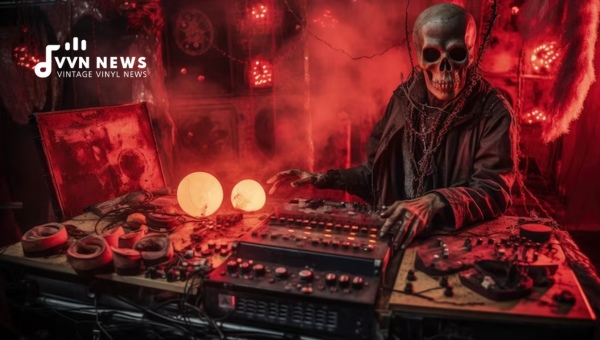The world of music is as mysterious as it is melodious, having its share of enigmatic incidents, eyebrow-raising plots, and spooky sagas that have taken the audience by storm over the years.
One such puzzling plot revolves around ’10 Satanic Songs- The Backmasking Panic!’— an absolute brain churner that has had music lovers and searchers of the supernatural alike in a tizzy.
Backmasking, ostensibly encoding hidden messages that can only be deciphered when a track is heard in reverse, took the world by storm during the Satanic Panic period in the United States.
Some messages were harmless easter eggs left by bands for their fans, while others supposedly contained cryptic satanic insights.
This controversy swept across households over dinner conversations and ignited debates on talk shows, turning this into an infamous chapter within our pop culture history.
Now let’s delve deep into this mysterious realm and uncover these ten peculiar tracks that continue to baffle us all.
Satanic Songs & Backmasking

Let me shed some light on an intriguing chapter in musical history steeped in mystery and ripe with controversy.
This particular topic dances around the delicate marriage between melodic tunes and the mystical world of the macabre.
Background of Satanic-themed music
Historically speaking, subliminal messages in songs began as playful experiments by musicians who wished to give their listeners an added layer of content to unearth.
“Satanic” music started taking form during the late 1960s when a few artists began using unconventional themes, contravening societal norms, and experimenting with darker undertones in their music.
One of the most iconic forms of this type of music was “Heavy Metal,” known for its elaborate guitar solos, screeching vocals, and high-energy performances.
Artists masked their deeper meanings using metaphorical lyrics—often open to interpretation by listeners.
This style contributed indirectly towards creating a climate for what would later become known as the “Satanic Panic.”
Definition of Backmasking
Backmasking, as mysterious as it sounds, is a recording technique where a sound or message is purposely placed backward in a track meant to be played forward.
While some artists used backmasking for artistic expression like The Beatles on “Rain,” others ostensibly utilized it for darker intent.
When played normally, these layers remain hidden within the song’s fabric and add to the overall ‘vibe’ or aesthetic appeal without conveying any explicit message.
But if played in reverse, an entirely different (and sometimes eerie) message can be detected.
Backmasking’s intent varies wildly– from innocuous Easter eggs and public announcements to revelations about Satanism depending on who you ask.
Far from being an accidental occurrence (which would be called phonetic reversal), backmasking is deliberate and requires meticulous planning and execution by the artist.
Evolution of Backmasking
From its humble beginnings, backmasking has etched a profound impact on the music scene. The technique first emerged in the mid-20th century with the advent of sound recording technologies.
Largely attributed to the whimsical experimentation by The Beatles in their 1966 hit “Rain,” backmasking quickly seized attention, prompting other artists to employ this unique concept into their compositions.
A scene of innovation emerged, where musicians challenged themselves to incorporate intricate backward messages, an art that involved calculated planning and precise execution.
In wrestling with these complexities, artists often hitched a ride on ambiguity to create multifaceted lyrical landscapes that took their music beyond banality and into the realm of the mesmerizingly mysterious.
In a relatively short span, an array of bands indulged in this inventive musical act like notably Led Zeppelin, Pink Floyd, Electric Light Orchestra and Queen—transforming what started as odd artistry into an industry-wide trend.
As backmasking continued to evolve, it took a darker turn when songs were rumored to contain satanic verses hidden within their reversed layers.
This ominous shift led to quite some furor among audiences and media across America providing us with numerous theories and interpretations for years to come.
Also Read: 20 Easy Flute Songs [Beginner-Friendly Pieces To Master]
Interpretation of Satanic Messages
Before plunging into the realm of hidden tracks in music, it’s crucial to understand how these supposed “satanic messages” have been interpreted.
With backmasking, the perceptions can be as varied as they are contentious.
Perception of Hidden Messages in Songs
For some people, finding satanic messages in backmasked songs is an act of pareidolia, a psychological phenomenon where the mind responds to a stimulus (an image or a sound) by perceiving a familiar pattern where none really exists.
This can lead to listeners ‘discovering’ creepy phrases in entirely innocent song segments. However, for others, this is an intentional and alarming practice.
These individuals genuinely believe that bands secretly implant diabolic or antisocial messages, intending listeners to absorb them subconsciously and behave accordingly.
Experiences with these tracks can range from harmless fun, fun-evoking smirks or laughter — to nightmares that fuel public outrage.
Nevertheless, it emphasizes an undeniable fact: the interpretation of these tracks largely depends on individual perceptions and beliefs.
Within this ever-evolving narrative, one truth remains: music isn’t one-dimensional; it’s vast, fluid and wonderfully mysterious–just like our interpretations of it.
Analysis of 10 Notorious Songs

These ten songs remain an integral part of the ‘Backmasking Panic’, having raised controversy and elicited intrigue due to their alleged Satanic messages.
Let’s clear the air by closely analyzing these notorious tracks.
1. Judas Priest – Better By You, Better Than Me
No stranger to the maelstrom of controversy stirred up by backmasking panic, Judas Priest landed in legal trouble due to this song.
The band faced allegations of using subliminal messages that allegedly drove two young men into a suicide pact.
The case was eventually dismissed, but it certainly added an eerier note to their already dark metal image.
2. Beyoncé – Sweet Dreams
Beyoncé’s ‘Sweet Dreams’, though a chartbuster, wasn’t spared the blushes when rumors circulated on the internet claiming listeners could hear a ‘nefarious’ hidden message with the song played backwards.
Sceptics were quick to snub these theories off as mere phonetic reversal rather than intentional insertion of backward content.
3. Pink Floyd – Empty Spaces
The iconic rock band Pink Floyd isn’t exempted from this list either! Some fans claim that portions of their song ‘Empty Spaces’ contain backmasked messages promoting drug use when played in reverse.
4. Queen, Another One Bites the Dust
A disco-influenced rock classic by Queen has also been rumored to have backmasking.
The song is supposedly saying, “It’s fun to smoke marijuana,” when played in reverse, a claim that has been met with skepticism and amusement alike.
It’s vital to consider that many of these allegations haven’t been conclusively proven, with continuous debates on whether these are examples of intentional backmasking or simply incidents of pareidolia— where one assigns significance to random or vague stimuli.
It all boils down to listener interpretations and individual perceptions- sparking diverse viewpoints and theories over time.
The impact that this handful of songs has had on popular culture is undoubtedly remarkable if not slightly unsettling.
Collectively they have fueled wild conspiracy theories, instigated lawsuits, birthed hoaxes and urban legends- making for talking points at social gatherings even decades past their release.
5. The Beatles – Revolution 9
Arguably one of the most experimental songs released by The Beatles, ‘Revolution 9’ always sat a little oddly with listeners, primarily due to its avant-garde composition.
What triggered mass paranoia was listeners claimed that playing the melody in reverse would reveal ‘Turn me on, dead man,’ hinting towards a long-standing conspiracy theory about Paul McCartney’s death.
6. Justin Bieber – Baby
Baby, Bieber’s breakout hit loved by teenagers worldwide, found itself amidst a storm when rumors spread that a backmasked message promoting Satan himself could be heard when played backward.
Critics argue that it’s nothing more than coincidental Phonetics and have debunked this theory.
7. Electric Light Orchestra – Eldorado
On the surface, Electric Light Orchestra’s track Eldorado is about a dreamer seeking solace in his fantasy world.
Some eagle-eared listeners claim to have discovered an unsettling message masked within its verses reading, ‘He is the nasty one—Christ you’re infernal—It is said we’re dead men—Everyone who has the mark will live.’
8. Owl City – Fireflies
Fireflies remains Owl City’s biggest hit, but not without controversy shadowing it. Paranoid theories suggest that behind its sugary-pop sound hides a dark subliminal message implying satanic worship when played backward.
9. The Eagles – Hotel California
Perhaps one of rock music’s timeless classics, Hotel California, was labeled with attributes of carrying illicit messages about Satanism courtesy of the backmasking technique.
Detractors believe specific reverse-played lines refer to satanic practices—an argument strongly refuted by avid fans and band members.
10. Led Zeppelin – Stairway To Heaven
Stairway To Heaven soars high on every Rock lover’s playlist but has swirled in mystery for decades now.
Asserted claims mention hearing ‘Oh here’s to my sweet Satan’ upon playing portions of it inn reverse-adding much fuel to the fiery debate regarding this masterpiece.
Also Read: 30 Best Songs Of All Time [The Ultimate Playlist For Music Lovers]
Societal Panic: Reactions & Consequences
The notoriety surrounding backmasking hit its crescendo during the Satanic Panic era that prevailed in the United States from the late ’60s through the ’80s.
A widespread fear of Satanic ritual abuse characterized this period. What started as subtle whispers soon grew into deafening rallies, with parents, religious leaders, and concerned citizens crying foul over what they perceived as sinister activities encoded within popular music.
With fingers pointed at some of the biggest names in music– artists like The Beatles and Led Zeppelin were accused of embedding subliminal Satanic messages in their songs.
The controversy was such that court cases were filed, with musicians forced to defend their work against claims of hidden demonic influences.
Reactively, fervent negative publicity led to public bonfires of albums believed to possess this hidden message, an eerie reminder of how collective paranoia can redefine cultural norms, reframing art into menace and musicians into alleged malefactors.
Simultaneously, this phenomenon gave rise to a new breed of novelty: an audience who reveled in deciphering these supposed cryptic messages.
This curiosity fuelled record sales as people sought to uncover those hidden “secrets,” thus ironically boosting the financial fortunes of those under scrutiny.
The societal panic surrounding Satanic backmasking poses a riveting commentary on public perception and its influence on pop culture.
It teaches us how rumors and innuendos can shape historical epochs—making it an unforgettable tale from music’s mythical annals.
Also Read: 33 Best Snoop Dogg Songs [Relive The Iconic Beats Of This Legend]
FAQs About Satanic Songs & Backmasking
What is Backmasking in music?
Backmasking is a recording technique where a sound or message is intentionally inserted backward into a track. When played in reverse, these hidden messages become discernable.
Why do musicians use Backmasking?
The reasons vary widely. Some musicians use Backmasking as an artistic tool and to hide playful easter eggs for their fans. In contrast, others have allegedly used it to relay subliminal messages, including purported satanic themes.
What was the ‘Satanic Panic’?
‘Satanic Panic’ was a cultural phenomenon that swept across the United States (and other parts of the world) during the 1980s. It involved widespread fear about alleged satanic ritual abuse conspiracies, which extended into various sectors of society – including music.
Are claims about Satanic Messages in songs genuine?
It is difficult to determine this unequivocally. Often, these claims are based on heated debates and individual interpretations of backward music tracks, with listeners contending they hear certain phrases or words when played in reverse.
Can I listen to backmasked songs myself?
Some online tools/sites allow you to play songs backward. However, due caution should be exercised, given the controversial nature of some backmasked content.
Conclusion
I believe it’s critical to understand that the backmasking phenomenon, whether containing overt Satanic messages or simply cryptic penmanship of musicians, is largely subjective.
During various periods in history, especially during the ‘Satanic Panic’, such whispers of ‘backmasked’ songs garnered more of a cultural momentum than truthful evidence.
It’s ultimately up to you, the music enthusiasts and amateur detectives alike, if you wish to fall these audio rabbit holes to unearth masterful compositions or eerily mysterious undertones.








